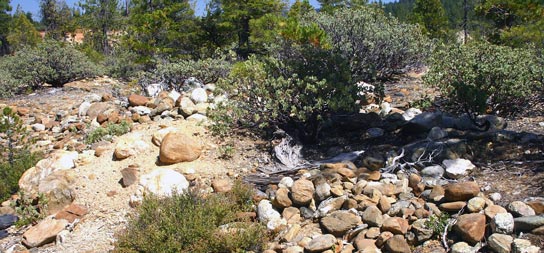One of the very best places to look for gold is where the old time miners were successful at finding it previously. They often left very obvious signs of their digging and mining, but at times these can become overgrown and hidden. They never got all of the gold, and perhaps most importantly, the old timers never had a tool that was anything like a metal detector. Here are some manmade indicators that you can look for in your quest for gold:
1. Ground cuts - These are basically the trenches in the ground from which ground sluicing gets its name. These narrow trenches carried the gravels to the sluice box.
2. Stacked rocks - in narrow and steep locations there was little room to move the rocks away. The old timers were forced to stack the rocks into walls alongside the stream they were mining.
3. Piles of rocks - In many locations the gravels contain rocks that are too large to pass through the sluice. These are tossed into piles which can cover hundreds of acres.

Piles of rocks and exposed bedrock between them indicate that this area was heavily mined in the past - I have found gold here
4. Areas stripped of their ground cover and top soils are often left behind as the mining operations processed these materials for their gold content. Sometimes tiny nuggets will get caught in the rough surface of the bedrock and this can be prime territory for VLF type nugget detectors, such as Minelab’s Eureka Gold and X-TERRA 705.
5. Ponds and Dams - Small scale ground sluice operations simply could not afford to bring water from long distances, so they built ponds close by to hold their water.
6. Dry Wash (Dry Blow) Piles - In the desert where sluicing was not possible, dry washers were used to process the gravels. These leave distinctive piles of coarse and fine screened materials that are right next to each other.
7. Potholes and Shallow Diggings - There are certain wind and water related processes that occur in desert environments which subtract light materials from the surface, leaving a concentration of heavy things like gold. They are worked with very shallow diggings.
8. Deeper Diggings: Adits and Shafts - Miners sometimes dug deep shafts, adits or other underground workings to access the concentrations of gold along bedrock buried beneath large amounts of overburden.
9. Hydraulic Mine Workings - Where the old miners found large deposits of gravel which had been left behind by the processes of erosion, if there was sufficient water nearby, they would dig trenches to bring it to the gravel and use the water pressure to wash the gravels away.
10. Dozer scrapes - Modern prospectors with access to metal detectors have learned to scrape off areas that are highly productive in order to access the layers of soil and gravel below which their detectors can “see”. These scrapes leave visible clearings and piles of pushed material. Many are still worth detecting – I’ve taken nuggets as large as half an ounce out of other people’s scrapes. Areas adjoining to scrapes can be productive as well.
Bedrock in and around old workings is always worth checking out. Sometimes it can be very productive, though not always.
Chris Ralph




















Comments
Shack